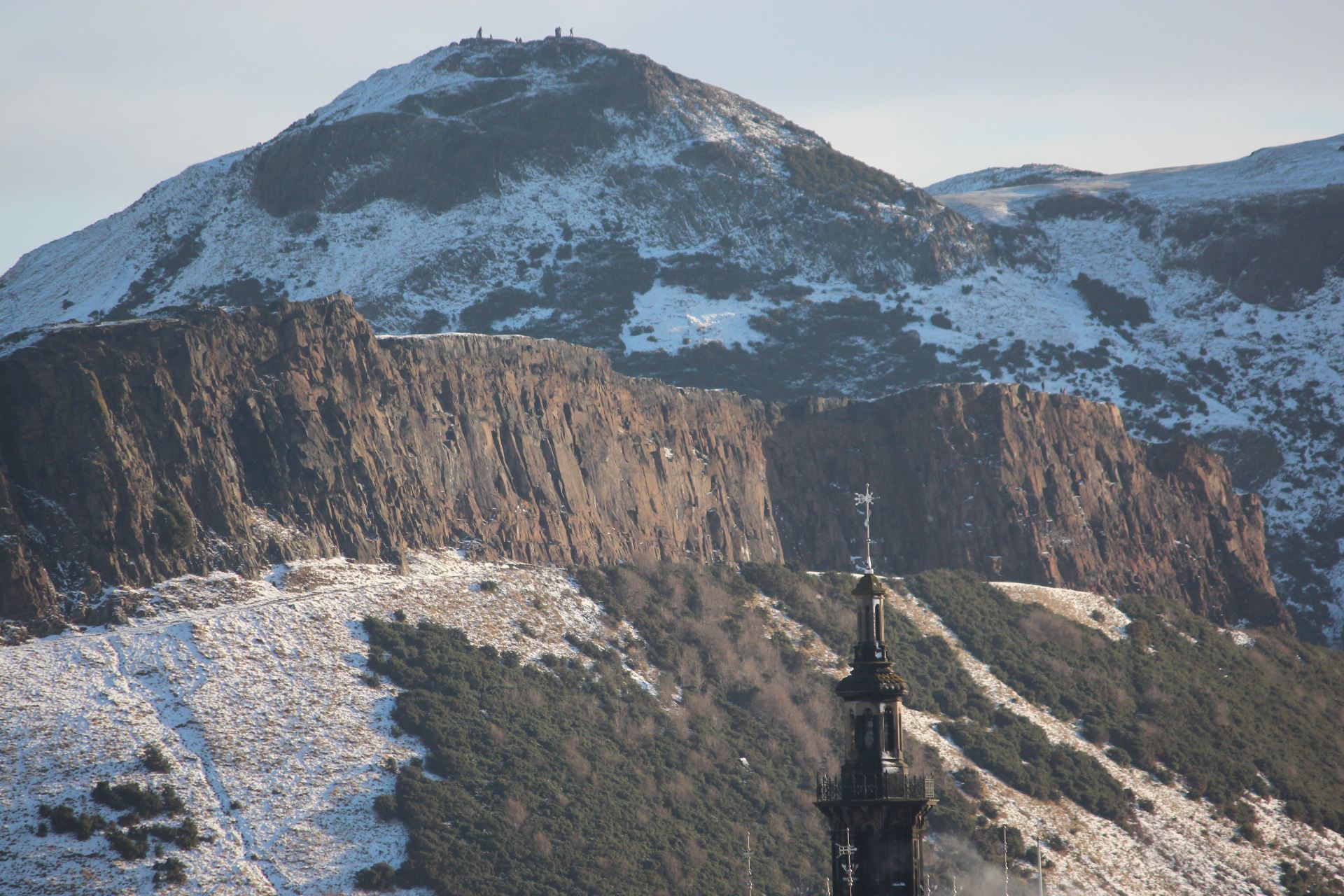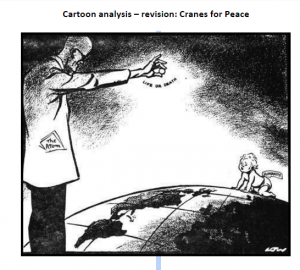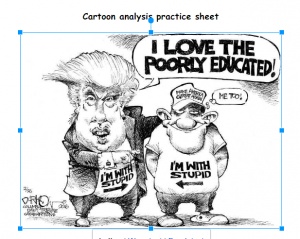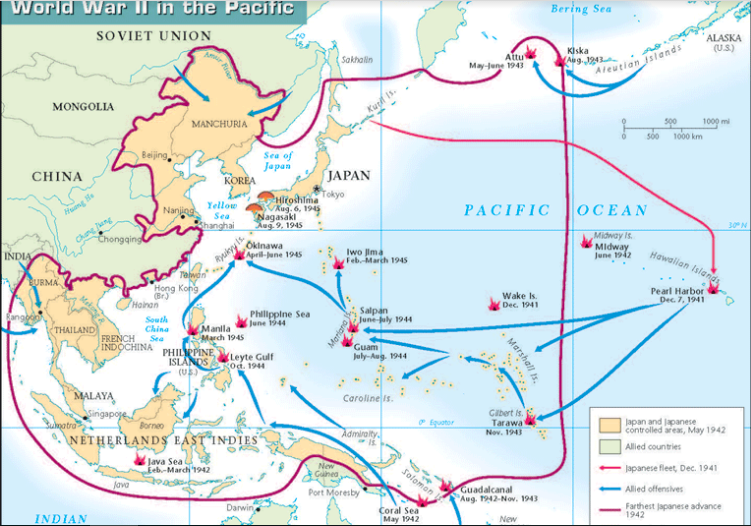Work through the revision document and ask for assistance.
Year 9 revision – 4 periods
Period 1 – Resource analysis cartoons and photos. (attached)
Cartoon from Cranes for peace booklet
Modern cartoon
Period 2 – Finding information
Background to the atomic bombing of Hiroshima
Why US and Japan went to war. China. Oil Embargo. Pearl Harbour.
Students will need computers. They are to go to these places and work in pairs:
http://teacher.scholastic.com/pearl/timeline/time5.htm
http://teacher.scholastic.com/pearl/timeline/time6.htm
http://teacher.scholastic.com/pearl/timeline/time7.htm
Students are to write down key names, dates and places and create a timeline.
Period 3 – Map and data analysis
Map of the course of the Pacific War. (attached)
On land and sea – a list of battles and the casualties suffered. (attached)
Period 4 – Cause and effect – Watch – 24 hours after Hiroshima.
https://www.youtube.com/watch?v=3yez_gesztE
Individually write down the effects that the bomb had on people.
Pair and share.
Structure as a paragraph.
Cartoon analysis – revision: Cranes for Peace
Source A: ‘Baby play with nice ball’ – a cartoon by David Low.
Look at Source A. This cartoon was published just after the atomic bombings of Hiroshima and Nagasaki. Answer the following questions.
- What is the name of the ball?
_________________________________________________
- Who is holding the ball?
_________________________________________________
- Why is humanity represented as a baby?
__________________________________________________________________________________________________________
__________________________________________________________________________________________________________
__________________________________________________________________________________________________________
- What do you think the cartoonist’s overall attitude to the use of the atomic bombs is?
__________________________________________________________________________________________________________
__________________________________________________________________________________________________________
Cartoon analysis practice sheet
Look at this cartoon and fill in the boxes below:
| What are the event(s) or issue(s) that inspired the cartoon? | Are there any real people in the cartoon? Who are they? |
| Are there any symbols in the cartoon? What are they and what do they represent? | What is the cartoonist’s opinion about the topic of the cartoon? |
| Do you agree with the cartoonist’s opinion? Why? | Anything else? |
Map work
- Which Australian city is on the map?
- What was the furthest south that the Japanese controlled?
- Which country was the furthest west that the Japanese reached?
- What was the furthest point west attacked by the Japanese?
- What was the name of the northern most islands Japan invaded?
- Which battle do you think stopped the Japanese advance towards New Zealand?
- Which two battles were fought in the Philippine Islands?
- Which country owned the Phillipines?
- What was the last battle fought before the Atomic bombs were used?
- What name are the Netherlands East Indies known as today?
Data Analysis
| Battle | Date | Number of US casualties | Number of Japanese casualties (most were killed) |
| Attack on Pearl Harbor | December 7, 1941 | 3,592 (2,345 killed and 1,247 wounded)[3] |
64 |
| Battle of the Coral Sea | May 4, 1942 – May 8, 1942 | 656 killed | 966 |
| Battle of Midway | June 3, 1942 June – 7, 1942 | 307 killed[12] | 3,100 |
| Battle of Guadalcanal | August 7, 1942 – February 9, 1943 | ~6,000 (1,600 killed, 4,400 wounded and missing)[13] |
19,200 |
| Battle of Tarawa | November 20, 1943 – November 23, 1943 | 3,296 (1,000 killed and 2,296 wounded)[3] |
4,690 |
| Battle of Saipan | June 15, 1944 – July 9, 1944 | 13,313 (2,949 killed and 10,364 wounded)[3] |
23,811 |
| Battle of Guam (1944) | July 21, 1944 – August 8, 1944 | 7,800 (1,747 killed and 6,053 wounded)[3] |
19,800 |
| Battle of Peleliu | September 15, 1944 – November 27, 1944 | 9,804 (1,794 killed and 8,010 wounded)[3] |
10,900 |
| Battle of Leyte Gulf | October 23, 1944 – October 26, 1944 | ~1,500 killed[3] | 49,000 |
| Battle of Iwo Jima | February 19, 1945 – March 26, 1945 | 26,038 (6,821 killed and 19,217 wounded)[3] |
22,000 |
| Battle of Okinawa | April 1, 1945 – June 22, 1945 | 51,429 (12,513 killed and 38,916 wounded)[3] |
110,000 |
- What is a casualty?
- In how many battles were there more US casualties than Japanese?
- What in this table supports the idea that most Japanese soldiers did not surrender?
- Which two battles cost the most in terms in terms of US casualties?
- What were the dates of those battles
How do the casualties suffered in those two battles help to explain the US decision to use the Atiomic bomb on 6th August 1945?



